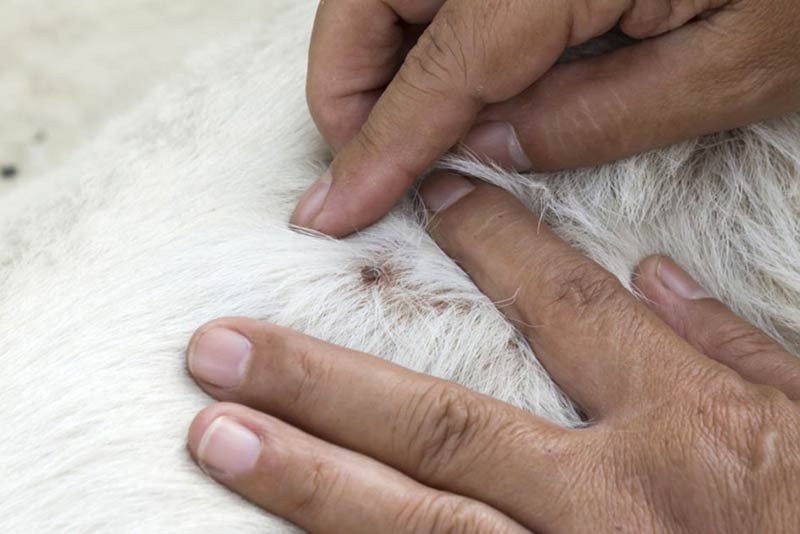Ticks suck. Literally. These eight-legged, spider-like insects are the nemesis of dogs and dog owners worldwide.
These common parasites are primarily active during the warmer months. They love to hide out in the dark and damp in woodlands and grasslands and catch a ride and a free meal off passing pooches. Unlike fleas, ticks don’t jump. They climb aboard or drop onto a passing host.
While ticks can also bite cats and humans, dogs are more susceptible to ticks and tick-borne diseases. It’s essential to know how to protect your dog against ticks and what to do if your dog does get it.
Stop Googling - Ask a Real Vet
As the weather gets warmer and we start to spend more time outdoors with our favorite companions, it’s vital that we’re armed with all the facts.
This article was reviewed by Dr. Chris Vanderhoof (DMV).
What does a tick look like on a dog?
Embedded ticks on dogs sometimes look like small scabs or scars and can often go overlooked. Before the tick has eaten, it can be the size of a tiny apple seed, but they fill up and become engorged once they eat. At this stage, they can become as big as your little fingernail.
An engorged tick on a dog is easier to spot than one that hasn’t filled up yet. Worse still is a tick nest on a dog. A dog can become the unwilling host to a mommy tick who lays her eggs in the soft, warm fur.
You’ll be able to spot these eggs easily. Look for a cluster of small translucent brown or red eggs. Removing these eggs is easy – use gloves to protect yourself from disease and pull the nest off. Soak it in alcohol to kill the eggs.
It’s a good idea to wash and groom your dog regularly, so you become familiar with their usual marks and scars. This way, it’s much easier to spot an unfamiliar mark that could potentially be a tick.
Ticks love a warm dark area, so start with those areas when you’re looking for ticks on your dog. There’s no cozier spot for a hungry tick than under a snug collar or a soft, floppy ear.
Finding ticks can be trickier if your dog has long hair, a dark coat, or a dense undercoat.
Sometimes a tick may bite your dog, eat its fill, and then drop off. In this instance, you won’t find a tick, but you may find a small tick scab on the dog where the bite occurred. Sometimes this tick bite on a dog after removal can get infected and develop a slight rash around it, swell, and itch.
Ticks come in a wide range of varieties that may look very different from each other. The region and environment where you live will determine the types of ticks that are prevalent and the types of diseases that they may transmit to both humans and animals.

photo credits: American Kennel Club (akc.org)
Can ticks make my dog sick?
Yes! Ticks carry diseases that can make humans and canines very sick. At the very least, a tick bite can cause skin irritation, but in some cases, tick-borne illness can cause potentially fatal diseases. Common tick-borne conditions in dogs include:
- Ehrlichiosis – is commonly transmitted by brown dog ticks. This disease causes fever, loss of appetite, enlarged lymph nodes, and sometimes even abnormal bruising. The area of the bite can sometimes become inflamed or scabby. If symptoms stick around longer than 24 hours after the tick is removed, it’s a good idea to contact your vet.
- Lyme Disease – is the most well-known of tick-borne illnesses. Transmitted by deer ticks, the disease can cause a rash, fever, mild lameness, loss of appetite, and lethargy. Lyme Disease is a severe illness in dogs, and if you suspect your dog may have it, don’t delay seeking treatment.
- Rocky Mountain Spotted Fever – can cause vomiting, stomach pain, and lethargy. It’s a common illness transmitted by American dog ticks, Rocky Mountain wood ticks, and brown dog ticks.
Symptoms of tick bites in dogs
Tick bites in dogs can cause a range of symptoms, from skin irritation to anemia and even paralysis. Look out for the following signs that a tick has bitten your dog:
- Vomiting;
- Retching, coughing, or loss of appetite;
- Changes in breathing – breathing rapidly or with difficulty;
- Lethargy;
- Loss of mobility or coordination in the hind legs, which may worsen into paralysis;
- Change in voice or bark.
How to check your dog for ticks
If your dog has recently been frolicking outdoors in long grass or wooded areas, it’s good to give your pooch a thorough all-over check.
Usually, the first sign that your dog has a tick is that your pooch will begin scratching the areas where they have been bitten. A tick bite may be small, but your dog will feel it, and it may itch or be sensitive to touch.
Check your dog for ticks by running your hands over your dog. Part the fur to look for ticks on your dog. Pay particular attention to the areas in and around the ears, eyelids, and under their collar. The areas under the front legs, between the back legs, around the tail, and between the toes are also crucial.
If you feel even just a slight bump – investigate further. It may be an embedded tick.
What to do if you find ticks on your dog
Eek! You’ve found a tick on your dog – now what? Your first step is to remove the tick as soon as possible.
Now, it may be tempting to get in there and pull the nasty critter off, but there are some essential things to know to make sure you do it right.
How to remove ticks from dogs
- Tweezers should be your weapon of choice. They make grabbing tiny and embedded ticks loads easier.
- You can also purchase a tick removal tool like a tick hook from your vet. It should come with instructions to help you get it right.
- Grab the tick as close to your dog’s skin as you can. Twist the tick and then pluck it away from the skin.
- It’s imperative that you don’t squeeze the tick’s body – this pushes blood back into your dog, increasing your dog’s risk of getting a tick-borne illness.
- Once you’ve removed the tick, put it into a sealed container for your vet to identify. The type of tick you remove will indicate the types of diseases your dog may have contracted.
- If you aren’t sure how to remove the tick yourself, speak to your vet.
- DO NOT: try to burn the tick off or use lotions or oils to suffocate the tick. These are old home remedies to remove ticks that don’t work!
Tick prevention
Prevention is better than cure, as the saying goes. And so it is when it comes to protecting your pooch from ticks.
Sticking to a strict tick prevention regimen is your best bet to protect your dog from ticks. There are various options available to you, from spot treatments, oral medications, and even natural tick killers. Chat to your vet about which option is best for your dog. Your vet will consider your dog’s coat, breed, lifestyle, and area where you live.
Since no preventative treatment is 100% foolproof, you should still check your dog frequently, especially after being out in long grass and woodlands.
Online Vet and Emergency Fund
If you think you may have found a tick on your dog, but you’re not super sure, it would be great to have someone to ask. Someone who doesn’t require an appointment and a lot of money.
With Petcube’s Online Vet, you have access to a team of qualified vets 24 hours around the clock, seven days a week. Hop on your phone and send a quick text message to one of the online vets, attach a photo or a video, and get a reply in real-time.
For just $20 a month, you have a team in your back pocket to put your mind at ease and offer advice when you’re unsure if a vet visit is necessary.
Avoid the nasty surprise costs that often come with having a fur child by adding on an emergency fund for an additional $9 a month. So, for $29 a month, you can have 24/7 vet help online and a $3000-a-year emergency fund to cover any emergency vet care.
FAQ
What do ticks look like?
Ticks come in a range of colors, shapes, and sizes. Generally, they are small, flat, and oval. Their colors can be black, red, white, brown, and grey.
Once a tick has fed, it swells up and can resemble a small coffee bean. Often ticks look like warts or skin tags, but you’ll see their little legs if you look very closely.
What does an embedded tick look like on a dog?
A tick on a dog can look like a skin tag, a mole, a scab, or a scar. Its head is buried deep in the skin.
What do I do if I find an infected tick bite on my dog?
If you find an infected tick bite, it’s essential to have it seen immediately. Typically, an infected bite will be itchy, and your dog will likely scratch at it. Redness and weeping are sure signs that infection has set in.
You can use over-the-counter wound cleaners and topical antiseptics obtained over the counter. Consult your vet if the infection doesn’t resolve in a day or two.
Are engorged ticks on dog bad?
This usually means that the tick has been there long enough to fill up on your dog’s blood. A tick that’s been on your dog for longer than a few hours can increase the chances of your dog contracting an illness. Remove the tick as soon as possible.
How to get rid of dog ticks in your home?
There are several products available to clean your home of ticks and fleas. You spray these along baseboards and in all the dark nooks and crannies that ticks love so much, and they typically work very well.
What to do if a tick’s head is stuck in your dog?
These remaining mouthparts and heads can still lead to infection even if they can no longer transmit diseases. It’s important to sterilize the area well. Never use disinfectant if the whole tick is still attached, increasing disease transmission. Consult your vet if you see increasing signs of infection.
Conclusion
You might not be overly thrilled to have to share this planet with pesky ticks lying in wait to bite into you and your beloved pets. While you can’t avoid them, you can prevent them from lunching on your dog.
Preventative care is, of course, always preferred. Especially in the case of ticks, as the diseases they spread can be life-threatening. Regular tick prevention and frequent checking of your dog can go a long way in preventing your pooch from suffering the ill effects of tick bites.

Was this article helpful?
Help us make our articles even better









